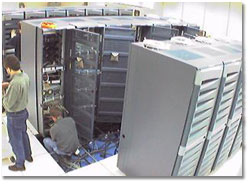 |
|
|
 |
||
| ||||||||||||||||||
|
Terascale Computing System Comes On-Line
|
||||||||||||||||||
|
Note: For additional photos of the TCS and a time-lapse video of its installation, see: http://www.psc.edu/machines/tcs/status/ |
|
The new Terascale Computing System (TCS) funded by the National Science Foundation (NSF) has begun operation well ahead of schedule and is exceeding performance expectations.
When NSF last August selected the Pittsburgh Supercomputing Center (PSC) as the TCS site, the agreement called for the system's first components to be operational by February 1, 2001. The high-performance computing system -- funded at $36 million, plus $9 million over three years for operating costs -- will eventually exceed six trillion operations per second (teraflops), making it the world's fastest for civilian research.
It turns out that the team at PSC works pretty quickly in its own right. With the computing system's manufacturer, Compaq, PSC's researchers and system engineers brought the initial 256-processor configuration on-line in late 2000 and have already used it to run research software weeks ahead of the February 1 target.
During a November 23 to December 22 trial in which PSC staff evaluated its performance, TCS consistently surpassed speed expectations and operated virtually without interruption. "PSC tells us the system ran for 99.98 percent of the testing time," said Bob Borchers, director of NSF's division for advanced computational infrastructure and research (ACIR). "With a number of actual research applications already having been run successfully, it's fair to say that TCS is off to a fast start."
Using LINPACK software - a standard performance test in which linear-algebra equations are the benchmark - the initial TCS achieved 75 percent of peak performance. That's speedy enough to rank 70th among supercomputing systems worldwide, despite its being just partially configured.
The initial TCS configuration has 64 interconnected Compaq ES40 Alphaservers, each of which features four EV67 microprocessors. By October, those servers and chips are to be replaced by more than 682 faster Alphaservers, each with four of Compaq's new EV68 chips. That will be a major advance compared to the largest currently installed Alphaserver systems, which have a maximum of 512 processors.
PSC is preparing the system for April 1, when researchers nationwide will begin in earnest to use TCS for projects with potential benefits such as more-accurate storm, climate and earthquake predictions; more-efficient combustion engines; better understanding of chemical and molecular factors in biology; and progress in understanding physical, chemical and electrical properties of materials. Access to the system is allocated competitively based on proposals to an independent review panel overseen by NSF.
On January 18, 2001, NSF also invited new proposals for a Distributed Terascale Facility (DTF) that will further broaden the research community's high-end capabilities. DTF proposals are due by April 19, and the award of $45 million - plus operating costs - will be made in mid-2001 after a team of computer scientists and other researchers reviews the proposals. The selection will be subject to approval by the National Science Board.
The DTF will reside at multiple sites, Borchers said, to capitalize on today's capabilities for distributed high-performance computing. "Together, TCS and DTF will represent a significant part of what is coming to be known as the Cyber-Infrastructure," he said. "Cyber-Infrastructure includes not only advanced computing systems and high-performance networks, but also the databases and devices needed for collection and visualization of vast data sets. NSF's Partnerships for Advanced Computational Infrastructure (PACI) are helping to provide many of these cutting-edge tools."
PACI currently funds two leading-edge sites: the National Computational Science Alliance at the University of Illinois and the National Partnership for Advanced Computational Infrastructure at the San Diego Supercomputer Center. Computer scientists at each site are already working with PSC to help make research software available through TCS.
![]()
For information about the DTF competition, see: http://www.nsf.gov/cgi-bin/getpub?nsf0151
PSC Press contact: Michael Schneider (412-268-4960 or schneider@psc.edu)
|
|
